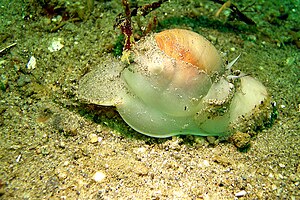Lewis moon snail
| Lewis moon snail | ||||||||||||
|---|---|---|---|---|---|---|---|---|---|---|---|---|

Lunatia lewisii in situ |
||||||||||||
| Systematics | ||||||||||||
|
||||||||||||
| Scientific name | ||||||||||||
| Lunatia lewisii | ||||||||||||
| ( Gould , 1847) |
The Lewis moon snail or Lewis umbilical snail ( Lunatia lewisii ) is a snail from the moon snail family that lives on the Pacific coast of North America . With a case diameter of up to 13 cm, it is the largest type in the family.
features
The spherical snail shell of Lunatia lewisii , which in adult snails can reach a diameter of up to 13 cm, has a deep umbilicus, at the edge of which a callus extends from the columella. A shallow groove runs up towards the seam. The basic color is yellow, the thin periostracum brown. There are clearly visible growth stripes and no further housing drawings. The dark brown operculum is horny.
When crawling, the snail shell is almost completely covered by the mantle. The active animal can expand its foot to four times the volume of the housing. The sinus system, which is characteristic of moon snails, which has 40 to 80 pores with sphincter muscles in this species, helps him here. Connective tissue along the sinus prevents the incoming seawater from coming into contact with nerves, muscle tissue, or blood. In the event of a malfunction, the water is expelled in a matter of seconds so that the reduced snail can completely retreat into the house and seal it with the operculum.
distribution
The Lewis moon snail occurs on the Pacific coast of North America from British Columbia ( Canada ) to Isla San Jerónimo ( Baja California , Mexico ).
habitat
Lunatia lewisii lives in protected bays, lower areas of the intertidal zone and below in depths of up to 150 meters on sandy or muddy subsoil. More snails are active at night than during the day. They come out after heavy rain and remain buried in the sand in cold weather.
Life cycle
There are roughly the same number of male and female juvenile snails, but the males die earlier. Males tend to be smaller and have thicker-walled housings. 90% of the snails with a 10 cm shell are female. From a shell length of about 5.5 cm, the snails begin to mate. The collar-shaped clutches made of sand and jelly are about 2 mm thick and have a diameter of about 20 cm at the base, but only about 7.5 cm at the top. The egg capsules are around 200 to 250 μm in size and each contain an egg. There are no eggs. The hatching Veliger larvae have a shell length of around 180 μm. At first they swim in the cavities of the gelatinous mass until it falls apart. They then go through a very short pelagic phase until they metamorphose into the finished snail . According to observations off Nanaimo ( Vancouver Island ), freshly metamorphosed snails eat diatoms growing on aquatic plants at a depth of 10 to 12 m, and later also seaweed . At an age of 5 to 6 months with a shell length of 5 to 6 mm, they begin to hunt small clams in the sandy soil. With a housing length of 3 cm, they also seek out shallow water. The snails live for several years.
nutrition
As with other moon snails, clams are preferred prey for Lunatia lewisii . In Nanaimo ( Vancouver Island ) the species Protothaca staminea and Clinocardium nuttallii make up the majority of the diet, in Bodega Bay ( California ) it is Macoma nasuta . The prey is sought when the snail plows through the sand with its propodium in zigzag movements. Uninjured mussels are perceived from a distance of 15 cm, meat without an enveloping shell from 2 meters. The victim is grasped with the foot and then a hole is drilled in the shell with the radula under the action of acid . On the lower lip of the proboscis there is a gland (ABO, accessory boring organ), the acidic secretion of which dissolves the calcium. Rasping with the radula and exposure to acid alternate until the hole is drilled. This process can take several hours and takes place buried in the sand. After a meal, the snail remains in the sand for up to 24 hours before it crawls away. In the laboratory, Lewis moon snails eat a large clam every four days. Holes drilled by moon snails are wider on one side than the other.
literature
- Donald Putnam Abbott, Eugene Clinton Haderlie: Prosobranchia , in: Robert Hugh Morris, Donald Putnam Abbott, Eugene Clinton Haderlie: Intertidal Invertebrates of California . Pp. 230-307, here pp. 270, 13.62: Polinices lewisii (Gould, 1847), Lewis's Moon Snail . Stanford University Press, 1st ed., Stanford (CA, USA) 1980. ( Google Books )
- Betty Jean Piech: Naticidae and Personidae: A Classification of Recent Species . Delaware Museum of Natural History, Wilmington, DE 1998, 60 pp.
Individual evidence
- ↑ RVK Pedersen, LR Page (2000): Development and metamorphosis of the planktotrophic larvae of the moon snail, Polinices lewisii (Gould, 1847) (Caenogastropoda: Naticoidea) . The Veliger, 43: 58-63
Web links
- Fischhaus Zepkow: Family Naticidae - moon snails
- Dianne Hoehing (2001), Animal Diversity Web: " Euspira lewisii "

